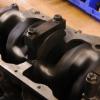I have an L-plate SPI Cooper but want to run it with a DCOE 45 carb arrangement. All the rest of the engine spec is pretty highly tuned so the carb should be well suited to the set up. I'd like to better understand if this is actually a viable route or if it will be an out-and-out failure based on the emissions.
I understand the age of vehicle needs a lambda sensor and cat fitted regardless of whether they're actually functioning. Today I spoke to my MOTer for my daily vehicle and he said many people remove the cat etc after the MOT cert has been issued. The exhaust I've specced for the car also doesn't have a lambda sensor port and even if it did, with no ecu for fueling present, it wouldn't be feeding any data/signal back to anything. The MOT guy said just make sure a lambda sensor is fitted even if not functional and make sure the wire is presented in such a way that it's not suspected for cheating - just take the car for its MOT and see if it passes...
I'm reluctant to do this in case it's going to be a dramatic failure and wondered if anyone had any knowledge/experience on the matter.
I do have a cat in the system.
The rest of the engine spec is: 1380, high end, big valve head (29-36mm), 286 cam, 1.5:1 rockers, large bore LCB and of course the DCOE 45 carb mounted on a 5" maniflow inlet. I'm also planning to use an ignition-only ecu which could help if programmed to meet an emissions spec??
Any thoughts or discussion is welcomed.
Thanks
Edited by PIIIOWW, 06 January 2020 - 10:14 PM.

















